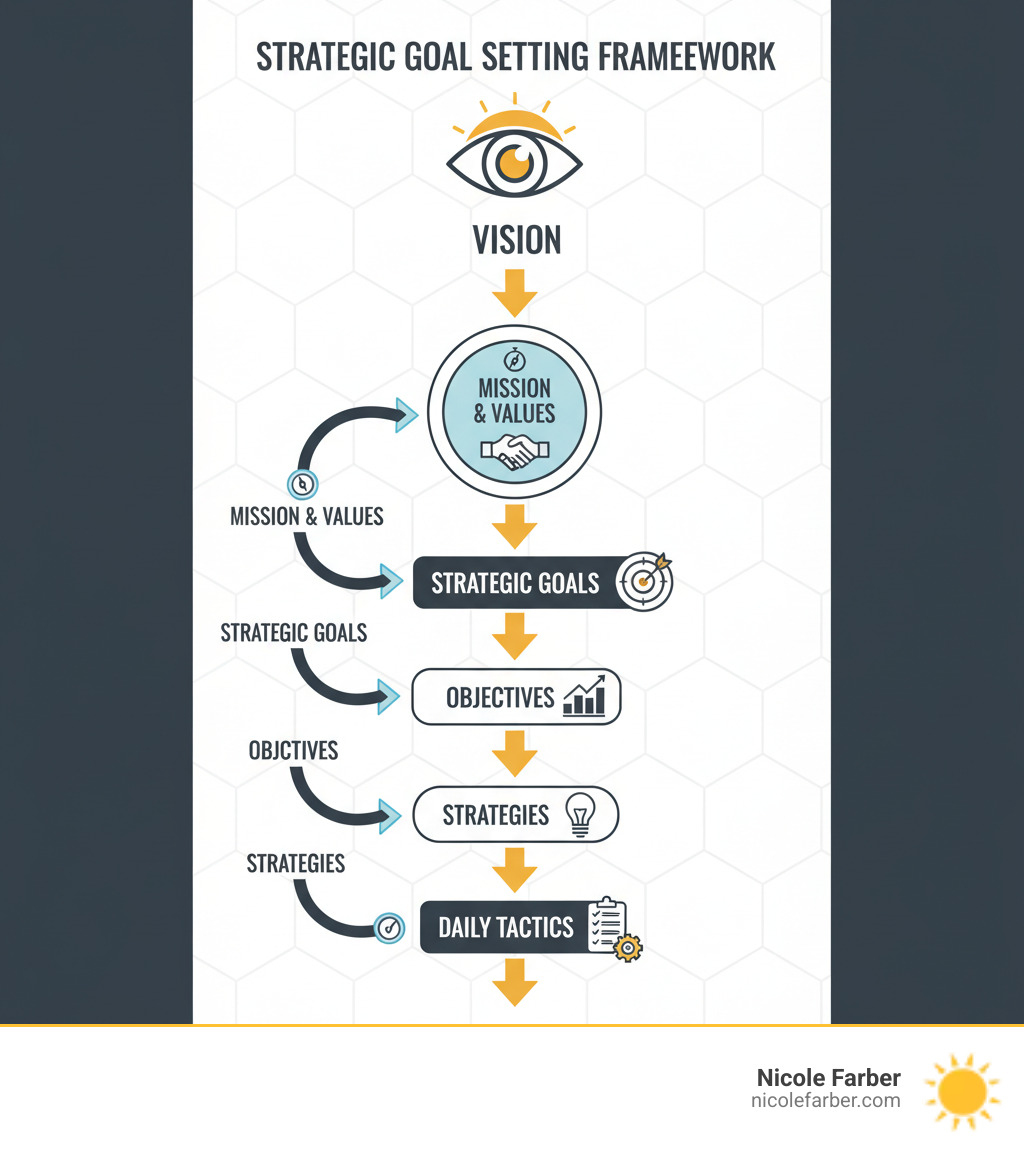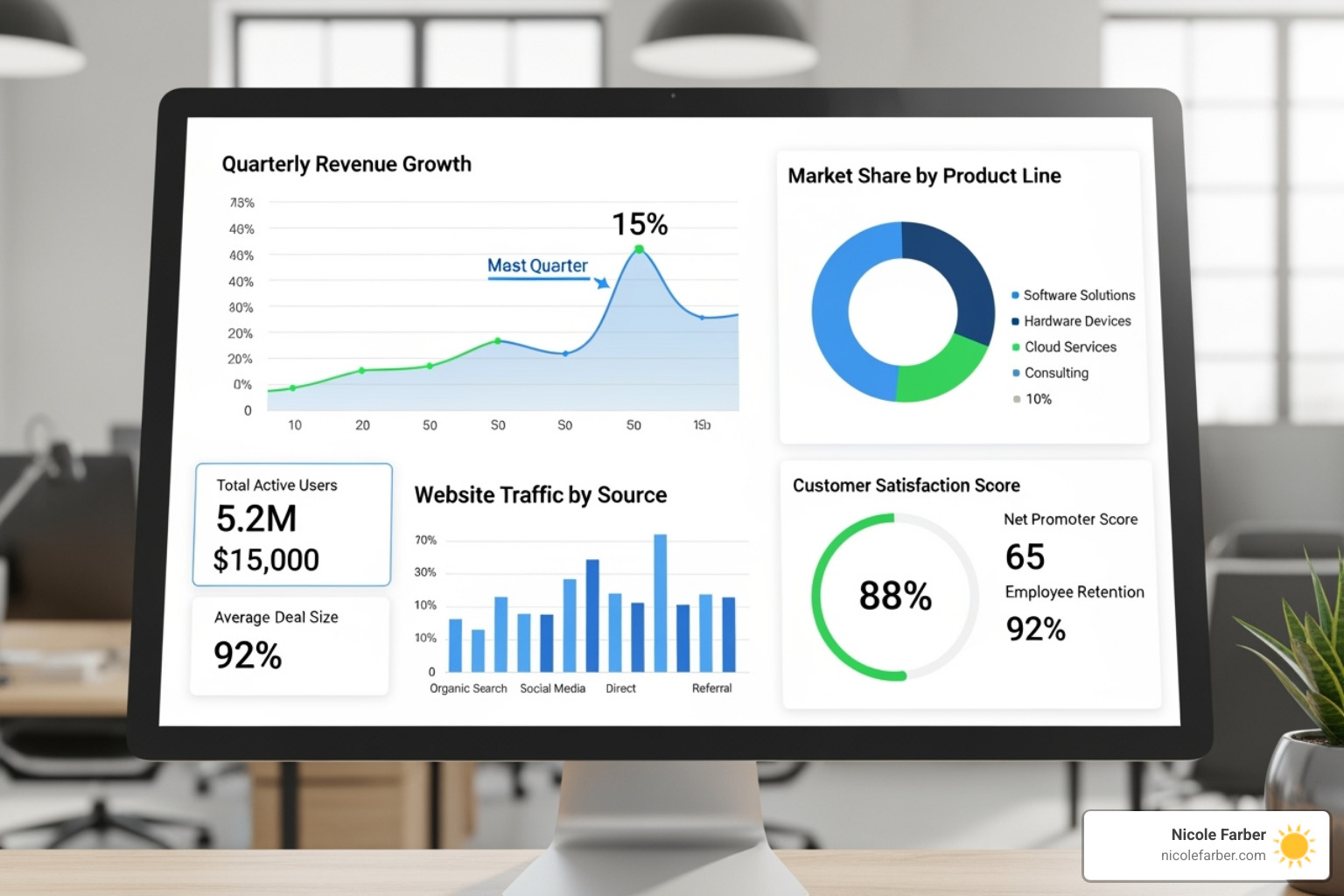The Strategic Advantage: Setting Goals for Unstoppable Progress
- Entrepreneurship
- Word of the Day
- October 22, 2025
Why Strategic Goal Setting is Your Key to Business Success
Strategic goal setting is the process of defining specific, measurable objectives that align with your organization’s long-term vision. It involves:
- Vision-driven planning: Translating your big picture into actionable steps.
- SMART criteria: Creating Specific, Measurable, Achievable, Relevant, and Time-bound goals.
- Alignment: Connecting daily work to organizational purpose.
- Measurement: Tracking progress with clear metrics.
- Adaptation: Adjusting strategy based on changing conditions.
A business without clear strategic goals is like a ship without a destination, wandering aimlessly. Research shows that organizations that set goals are 30% more likely to achieve them, and those with strategic plans report 30% higher success rates. Yet many business owners, from Philadelphia to New Orleans, struggle to move beyond daily firefighting to create meaningful direction.
The challenge is creating a hierarchy of goals, objectives, and tactics that work together. It’s ensuring your team understands not just what to do, but why it matters. The power of strategic goal setting lies in changing abstract visions into concrete action plans that guide decisions and priorities. It becomes your business compass, pointing toward sustainable growth.
I’m Nicole Farber. With over 15 years of experience turning around businesses, I’ve seen how strategic goal setting separates thriving practices from those that merely survive. My work has shown me that clear, purposeful goals are essential for any leader serious about building lasting success.

The Foundation: Why Strategic Planning is Your Business Compass
Think of strategic planning as your business GPS. You wouldn’t drive cross-country without a destination, and you can’t build a thriving business without a clear roadmap. Strategic planning is the ongoing process of charting your company’s course forward. It’s continuous, not a one-time event; your plan evolves as your business grows and market conditions shift. Whether you’re running a law firm in Philadelphia or expanding to New Orleans, this compass keeps you pointed toward true north.
Strategic planning transforms chaos into clarity. Instead of your team pulling in different directions, everyone moves toward shared goals. People become more engaged because they see how their work fits into a bigger picture, and you make smarter decisions about time and money. Most importantly, it builds adaptability into your business DNA, giving you a framework for making tough decisions when challenges arise.
The most powerful strategies come from authentic alignment between who you are and what your business stands for. As a single mother who has built and turned around businesses, I’ve learned this firsthand. Research like the A Theory of Goal-setting & Task Performance confirms that clear goals and regular feedback boost performance. This isn’t just about profit—it’s about creating meaningful impact through faith-driven leadership. For more on this, see our guide on Building a Successful Business.
The Core Trio: Vision, Mission, and Values
Every successful business, from a startup in Wilkes-Barre to an established practice in Luzerne County, is built on three essential elements.
- Your vision is your North Star: an inspiring picture of what success looks like in five or ten years. It’s the big, bold dream that answers, “If everything goes right, what will we have accomplished?”
- Your mission is the “how”: it guides today’s decisions by defining who you serve, what value you deliver, and what makes you different.
- Your values are your non-negotiable principles: the beliefs that shape every decision. For me, faith-driven leadership means values of integrity, service, and empowering others.
Connecting purpose to performance isn’t fluff. Harvard Business School research shows that when purpose links to strategic vision, companies can outperform competitors. Imagine a Philadelphia business with a vision to be the most trusted legal marketing partner in the tri-state area. Their mission is to deliver innovative strategies, and their values are transparency and client success. This foundation attracts the right clients and team members.
From Broad Vision to Focused Action
The gap between “big dreams” and “daily reality” is where most businesses get stuck. Strategic goal setting bridges this gap by translating abstract ideas into concrete action plans. It breaks your vision down into specific, measurable steps your team can accomplish. Instead of “become the best,” you get “increase client retention by 15% in our New Orleans office by Q4.”
This clarity is a powerful motivator. When people see how their work contributes to something meaningful, productivity soars. Research shows organizations with clear goals are 30% more likely to achieve them, and SMART goals are 42% more effective.
Strategic goal setting also guides resource allocation. With clear goals, decisions about where to invest time, money, and talent become obvious. You stop saying yes to every opportunity and start saying yes to the right ones. Whether you’re managing operations from Philadelphia to Antigua Guatemala or growing a local practice, strategic goals ensure every effort moves you closer to your vision. For more strategies, explore our Business Leadership Strategies guide.
A Step-by-Step Guide to Effective Strategic Goal Setting

From my experience helping businesses from Philadelphia to New Orleans, I’ve learned that strategic goal setting isn’t just writing down wants. It’s creating a roadmap with actionable steps, measurable outcomes, and accountability that moves the needle. It requires the same intentional planning as a cross-country trip.
Step 1: Clarifying the Hierarchy (Goals, Objectives, Strategies, Tactics)
A common mistake is mixing up goals with daily tasks. The GOST model (Goals, Objectives, Strategies, Tactics) creates a clear hierarchy connecting your biggest dreams to your smallest actions. This model helps “optimize work efforts and breaks down the difference between outcomes and actions.”
Here’s an example for a goal to “Increase Client Satisfaction”:
| Element | Definition | Focus | Example |
|---|---|---|---|
| Goal | Broad, long-term outcome. | The “outcome.” | To be recognized for exceptional client service. |
| Objective | Specific, measurable step. | How we’ll measure progress. | Achieve a client satisfaction score of 9.0/10 by Q4 2025. |
| Strategy | The plan to meet an objective. | The “how” or approach. | Implement a personalized client communication program. |
| Tactic | Individual action. | The “what” or specific task. | Assign a dedicated client success manager to each client. |
Your goal is the inspiring vision. Objectives are measurable milestones. Strategies are the game plan, and tactics are the daily actions. When a law firm in Luzerne County uses this framework, everyone understands how their work fits into the bigger picture. For more on navigating planning challenges, see our guide on Overcoming Business Challenges.
Step 2: Crafting Powerful Goals with the SMART Framework
Vague goals like “grow the business” are wishes, not goals. The SMART framework transforms wishes into achievable targets. Research shows SMART goals are 42% more effective than vague ones.
- Specific: Answer the five W’s. Instead of “improve client service,” try “increase client satisfaction ratings for our Philadelphia office.”
- Measurable: Include numbers that matter. How will you know you’ve succeeded? Use a score, revenue target, or retention rate.
- Achievable: Stretch yourself without breaking. A goal should be challenging but realistic.
- Relevant: Align with your bigger purpose and mission. Every goal should connect back to your “why.”
- Time-bound: Have deadlines that create healthy urgency. “By December 31st, 2025” is a deadline; “someday” is an excuse.
For more, the How to write SMART Goals guide offers excellent insights. Well-crafted goals look like this: Increase client retention by 15% in our New Orleans office by Q4 2025 or Reduce operational costs by 10% by the end of 2026.
Step 3: Prioritizing Your Strategic Goals for Maximum Impact
You have more ideas than time and resources. Trying to do everything means achieving nothing well. Strategic prioritization is about focusing your energy where it will have the biggest impact.
Start by calculating anticipated ROI for each potential goal. The Harvard Business School suggests the formula: ROI = (Net Profit / Cost of Investment) x 100. This helps you think critically about which goals will move your business forward.
Next, use the Eisenhower Matrix to consider urgency versus importance. Most strategic goals are important but not urgent, so they’re easy to push aside. Don’t let that happen.
Also, align with your core strengths. If your superpower is building relationships, prioritize goals that leverage that strength. Working with your natural abilities increases your chances of success.
Finally, make tough choices for focused execution. Strategic planning is as much about what you won’t do as what you will. Choose three to five strategic goals maximum and commit fully to them. That focused energy creates unstoppable progress.
Frameworks and Models to Structure Your Strategy

Think of strategic goal setting frameworks as a toolbox for building your business. Over 60% of organizations use them because they turn complexity into manageable, actionable steps. These time-tested tools help you see clearly through the fog of daily operations. Whether you’re running a law firm in Philadelphia or expanding to Antigua Guatemala, the right framework provides structure and keeps everyone rowing in the same direction.
Analyzing Your Environment: SWOT and PEST
Before setting a course, you need to understand the landscape. Two powerful frameworks for this are SWOT and PEST.
SWOT analysis examines internal factors (your Strengths and Weaknesses) and external factors (the Opportunities and Threats in your market). Your strengths might be a skilled team or deep community ties, like those in Luzerne County. Weaknesses could be outdated technology. Opportunities might be growing demand for a service, while threats could be new competitors. A New Orleans law firm might see its local roots as a strength but recognize manual processes as a weakness.
PEST analysis takes a broader view of the macro-environment:
- Political: Government policies and regulations.
- Economic: Interest rates and local employment trends.
- Sociocultural: Changing demographics and client expectations.
- Technological: Innovations that could disrupt your industry.
When analyzing the business environment in Wilkes-Barre, you might consider local government incentives, regional economic health, and technology adoption rates. This comprehensive view helps you build strategies that work. For a deeper dive, explore PEST analysis explained.
Structuring for Action: The Balanced Scorecard and OKRs
Once you understand your environment, you need frameworks to translate insights into action. The Balanced Scorecard and OKRs are excellent tools for this.
The Balanced Scorecard provides a “balanced” view across four perspectives: Financial (revenue, profitability), Customer (satisfaction, market share), Internal (operational excellence), and Learning & Growth (team capabilities, technology). Used by over half of Fortune 1000 companies, it connects daily work to strategic outcomes. The Balanced Scorecard Institute offers comprehensive resources.
Objectives and Key Results (OKRs) are designed for setting ambitious Objectives paired with specific, measurable Key Results. An objective might be “Transform our client onboarding experience,” with key results like “Achieve an NPS score of 70 for new clients” and “Reduce onboarding time by 50%.” The magic of OKRs is in cascading goals from the top down, creating transparency and alignment. Whether your team is in Philadelphia or spread across multiple locations, OKRs keep everyone focused on what matters most.
Bringing Your Strategy to Life: Measurement, Accountability, and Adaptation

This is where your strategic goal setting transforms from ideas into real business results. A strategy without execution is just wishful thinking. The difference between thriving businesses and those that struggle is their ability to consistently measure progress, hold themselves accountable, and adapt to the inevitable curveballs.
Measuring What Matters: KPIs and Progress Reviews
Think of Key Performance Indicators (KPIs) as your business’s vital signs. They tell you whether your strategic goals are alive and thriving. The key is to focus on what’s truly “key.” If your goal is increasing client retention in your Philadelphia office, the most critical KPI is your client churn rate.
A strategy scorecard brings these vital signs together in one place, giving you a command center for making informed decisions. Regular check-ins and review meetings are where accountability comes alive. These aren’t blame sessions; they are energizing conversations about problem-solving and celebrating wins. As research shows, regular feedback dramatically boosts performance.
As a CEO coach, I’ve seen the power of a culture of accountability. When everyone understands their role, it creates unstoppable momentum. This is the level of insight we focus on in our CEO Coaching Services.
The Art of the Pivot: Adapting in a Changing World
Your original strategic plan will need to change. Not because you did it wrong, but because the world doesn’t stand still. Markets shift, new technologies emerge, and global events can reshape business overnight.
I saw this during the pandemic, as businesses in Luzerne County and beyond scrambled to adapt. The ones that thrived treated strategy as an ongoing process, not a fixed blueprint. As the Harvard Business Review on strategic planning notes, a good plan evolves. The biggest risk isn’t making a mistake; it’s becoming so attached to your plan that you miss signals to adjust.
Building resilience means knowing when to pivot without abandoning your core vision. When firms expand from markets like New Orleans to new territories like Antigua, Guatemala, this adaptability is crucial. The vision may remain, but strategies must flex. This isn’t a sign of weakness—it’s the hallmark of unstoppable progress.
Frequently Asked Questions about Strategic Goal Setting
What is the biggest mistake companies make in strategic goal setting?
From my work with businesses in Philadelphia, New Orleans, and beyond, I see a few common pitfalls. The most frequent mistake is setting too many goals at once. This spreads resources too thin, and nothing gets the attention it deserves.
Other major stumbling blocks include:
- Lack of clarity: Goals that aren’t specific and measurable become moving targets that no one can hit.
- Disconnecting goals from daily work: Strategic plans gather dust while employees remain unaware of how their efforts contribute to the bigger picture.
- Poor communication: If the team doesn’t understand the “why” behind a goal, they can’t make meaningful contributions.
- Forgetting the purpose: Without a connection to the mission and values, goals become mere checkboxes instead of inspiring aspirations.
How often should a strategic plan be reviewed and updated?
The right review rhythm is crucial for maintaining momentum. I recommend a three-tier approach:
- Annual deep reviews: A comprehensive check-up to evaluate your vision, mission, major goals, and the external environment. This allows for significant course corrections, whether you’re in Wilkes-Barre or expanding to Antigua Guatemala.
- Quarterly progress checks: Agile sessions to assess tracking against objectives and make tactical adjustments. Market conditions in Luzerne County might shift, warranting a change.
- Monthly KPI monitoring: Real-time feedback from your Key Performance Indicators to enable quick corrections before small issues become big problems.
The key is flexibility over rigid schedules. While this structure is a good guide, be prepared to adapt when major events occur. Sometimes, strategic pivots can’t wait for the next quarterly review.
How can a solo entrepreneur or small business apply strategic goal setting?
Strategic goal setting is just as powerful for solo entrepreneurs as it is for large corporations. The principles are the same; only the scale changes. As a single mother building my own business, I learned that clarity is even more critical when you’re wearing multiple hats.
- Focus on 1-3 core goals maximum. This is about thinking smart, not small. Identify the few objectives that will truly move your business forward.
- Scale down the frameworks. You don’t need a complex Balanced Scorecard, but you can still consider the four key areas: financial health, client satisfaction, operational efficiency, and your own growth.
- Use personal strategic planning techniques. Simple frameworks can help align your personal aspirations with business objectives, which is crucial when you are the business.
The core principles of SMART goals matter just as much for a solo venture in Philadelphia as they do for a multinational. Your dreams deserve strategic rigor. For more personalized guidance, explore our resources on Empowering Business Owners.
Conclusion: Your Strategy, Your Success
We’ve journeyed through strategic goal setting, from building a foundation with your vision, mission, and values to crafting powerful SMART goals. We’ve explored frameworks that bring clarity and discussed how to measure what matters while staying adaptable.
Remember this: the power of intentionality and clear direction is your secret weapon. Whether you’re growing a practice in Philadelphia, expanding to New Orleans, or exploring opportunities in Antigua Guatemala, a strategic compass makes all the difference.
Strategic goal setting is more than a business task; it’s a life skill that transforms how you lead and inspire. As a single mother who built a business, I know that clear goals are what keep you moving forward when things feel overwhelming. This process is about translating your deepest dreams into concrete realities and using your time and energy wisely.
My approach is rooted in faith-driven leadership. I believe that when we combine clear strategy with authentic purpose, unstoppable progress becomes inevitable. I’ve seen it happen time and again with the women leaders I work with, from Wilkes-Barre to beyond.
Your strategy is waiting. Are you ready to create the roadmap that will get you there?
Ready to define your “North Star” and chart your course? Let’s work together to open up your full potential. Start your journey with life coaching for women.
